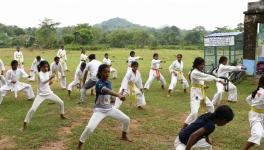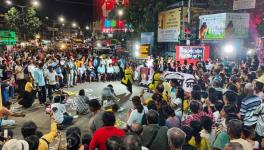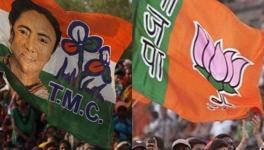Left, Media Apathy and the Rise of Social Media
Representational use only.
Kolkata: The Left has always faced media apathy, more so in recent times, especially in West Bengal. With most media houses now guided by corporate interests rather than the ideals of journalism, they have started treating readers as buyers, which makes them determine what kind of news sells.
The present scenario has, therefore, become grim as corporate interests take precedence over people’s interests. And since the Left has always been on the other side of corporate interests, it has been at the receiving end of media ire.
Such is the corporatisation of media that now big corporate groups, such as the Ambanis, have taken over the media, both print and television, across major regional languages as well as English. The group has direct control over some channels while in others, corporate advertisement flow indirectly holds sway over news projection.
This ‘carrot and stick’ approach is not restricted to corporate houses but governments as well, since a huge chunk of the advertisement flow to the media pertains to the government sector. Hence, showing farmers protests will definitely invite the stick, while pro-Bharatiya Janata Party (BJP) or government news will ensure carrots.
When it comes to West Bengal, BJP, a corporate favourite, would win hands down when it comes to television news. For instance, a channel -- TV9 -- which predominantly operates in Southern and Western India, opened shop in the state just before the Assembly elections. Then there is West Bengal’s leading news channel – ABP Ananda – which is constantly projecting the electoral fightin Bengal as a binary one – between BJP and Trinamool Congress with one foot firmly rooted with the ruling TMC and the other with the BJP, which is ruling at the Centre.
No surprise then that a 10-lakh strong Left-Congress-ISF rally at Brigade Ground in Kolkata goes off the main news within few hours, while a miniscule rally by BJP gets bigger play.
Another news channel, a distant second in popularity, which had earlier been funded by a Left-supported consortium, has been taken over by the Zee group. This channel is also feeding the market with a binary political narrative during the Assembly elections.
Commenting on this trend, former CPI(M) member of Parliament, Mohd Salim, had recently tweeted that a leading English newspaper – The Telegraph – of the ABP group had, for the first time in the past four years, given page one coverage to a CPI(M) programme when former Tripura chief minister Manik Sarkar addressed a rally in Burdwan.
Present scenario
Apart from this, there are a cluster of about 10 to 12 satellite channels operating in the state, which are considered “extensions” of the ruling TMC as some of its party leaders are reportedly hugely invested in these. Some BJP leaders from Assam also are reportedly invested in some news channels in West Bengal.
Interestingly, the social media sector is now seeing a boom with an influx of digital news channels. Some of these in Bengal have come up before the elections and are reportedly being funded by the extreme Right camp.
However, in the social media, the Left still has considerable clout and is ahead of BJP, according to some media analysts.
In the past, newspaper readership was mainly concentrated among the elite educated people, be it in the urban or rural areas. During Left Front rule, a widespread literacy drive helped increase newspaper readership in West Bengal. Later, with the advent of news channels, television viewership also increased manifold.
Past Incidents – Rabindra Sarobar
In April 1969, there was violence over a function at Rabindra Sarobar. A day after the function, there were no reports of misbehaviour with women in any newspaper. However, after two-three days, some newspapers started publishing ‘spicy’ stories targeting the then United Front government’s home minister, Jyoti Basu. Reports claimed that several people had been killed and bodies of women were found near the Sarobar (lake). This incident created ripples outside the state too. Basu ordered a departmental enquiry. The investigation commission called all reporters to give witness. However, only reporters from The Statesman and Hindustan Standard turned up and said they couldn’t recount any incident of indecent behaviour with women. When the report of the commission came out on December 16, 1969, it said there was no incidence of misbehaviour with women that day.
Marichjhanpi : What actually happened?
Another incident that is still used to “malign” the Left Front government was the police firing at Marichjhapi in Sunderbans area. On January 31, 1979, there was an incident of police firing at Marichjhapi to “clear out” refugees from the area. On February 1, Ananda Bazaar Patrika reported the firing, saying “6 killed, 5 injured at Kumirmari”, which is just opposite Marichjhapi. The six who were killed in police firing were refugees. This incident created a grave situation in the political scenario of Bengal.
But what had actually happened in Marichjhapi?
According to Left sources, a group of refugees tried to cross the river from the island of Kumirmari with around 200 local people were shouting slogans in support of these people, but the security forces stopped them. The refugees allegedly attacked the security forces with bows and arrows. The police then fired tear gas. After this, around a thousand people “attacked” the Kumirmari police camp. On instructions from the officer in-charge, the police fired two rounds. When the crowd dispersed, police from another camp came to the rescue the police force of the Kumirmari Camp, but were attacked from both sides by the crowd. Police then fired 20 rounds of tear gas, and claimed that the armed mob shot arrows at them, leaving 18 policemen injured. Police then fired in which six people were injured. There were two casualties -- a woman died on the spot and another person died at the hospital, said Left Front sources.
In 1979, though media didn’t have such an overwhelming presence then, politics began over the number of deaths. In his speech on the Assembly on the issue, then Chief Minister Jyoti Basu said:“leader of Janata Party, Dilip Chakraborty had said that 77 people had died at Marichjhapi. Why it’s 77 or 107 or 180, I don’t’ know, but we are saying only two people have died there. Dilip Chakraborty had met me and when asked him the names of the people who have died and their addresses, he replied he had heard it from a police officer and that it will take him some time to gather the details. But he has not reported back yet’
Left Front Targeted
Within a year of the Left Front government coming to power, many refugees were misled and were given false hopes and “forced” to come to West Bengal from Dandakaranya and other such places. They were told by some people to leave their rehabilitation centre and land that they obtained from the Centre and come to Bengal. I
In spite of knowing at that time that there was no possibility of rehabilitating more refugees in Bengal, this was done with the objective of tarnishing the Left Front’s image, said the sources.
The Bengal government said it tried to address the problem but some “unscrupulous people fell down trees, illegally cut ponds and started distributing land to these refugees illegally.” Some so called leaders said that they have the documents of these lands and sold the fake documents for Rs 100 or Rs 50,” said sources.
For a long time, Marichjhapi remained cut off from the rest of the state as the administration could not enter for months. It was made “Muktanchal” (liberated zone).
Most media houses at that time continually attacked the LF government and CPI (M).
There are other such instances, too, where media’s involvement in “political conspiracies” has led to targeting the Left governments, be it in Bengal, Tripura or Kerala.
For instance, the first communist government had come to power in Kerala in 1957 under the leadership of EMS Namboodiripad. Conspiracies continued against this government led to its fall in 1959. In 1988, the same thing happened in Tripura, where CRPF, police professional criminals were used to rig the polls.
Media Power
In the present world, the media is undergoing many changes. In yesteryear, media meant newspapers, radio, TV etc. Now there are many new mediums. For example, mobile phones, personal computers, laptops etc. have regular news updates. Then, there are added facilities of SMS, MMS, WhatsApp, social media etc. Hence the future might not be as grim as it was earlier for the Left, which has now started banking heavily on social media to get its campaign and views across.
The writer is indebted to an article on ‘Vicissitude of Media: Past incidents, today’s’ ripples and the media of future’ by late Avik Dutta. The views are personal.
Get the latest reports & analysis with people's perspective on Protests, movements & deep analytical videos, discussions of the current affairs in your Telegram app. Subscribe to NewsClick's Telegram channel & get Real-Time updates on stories, as they get published on our website.
























